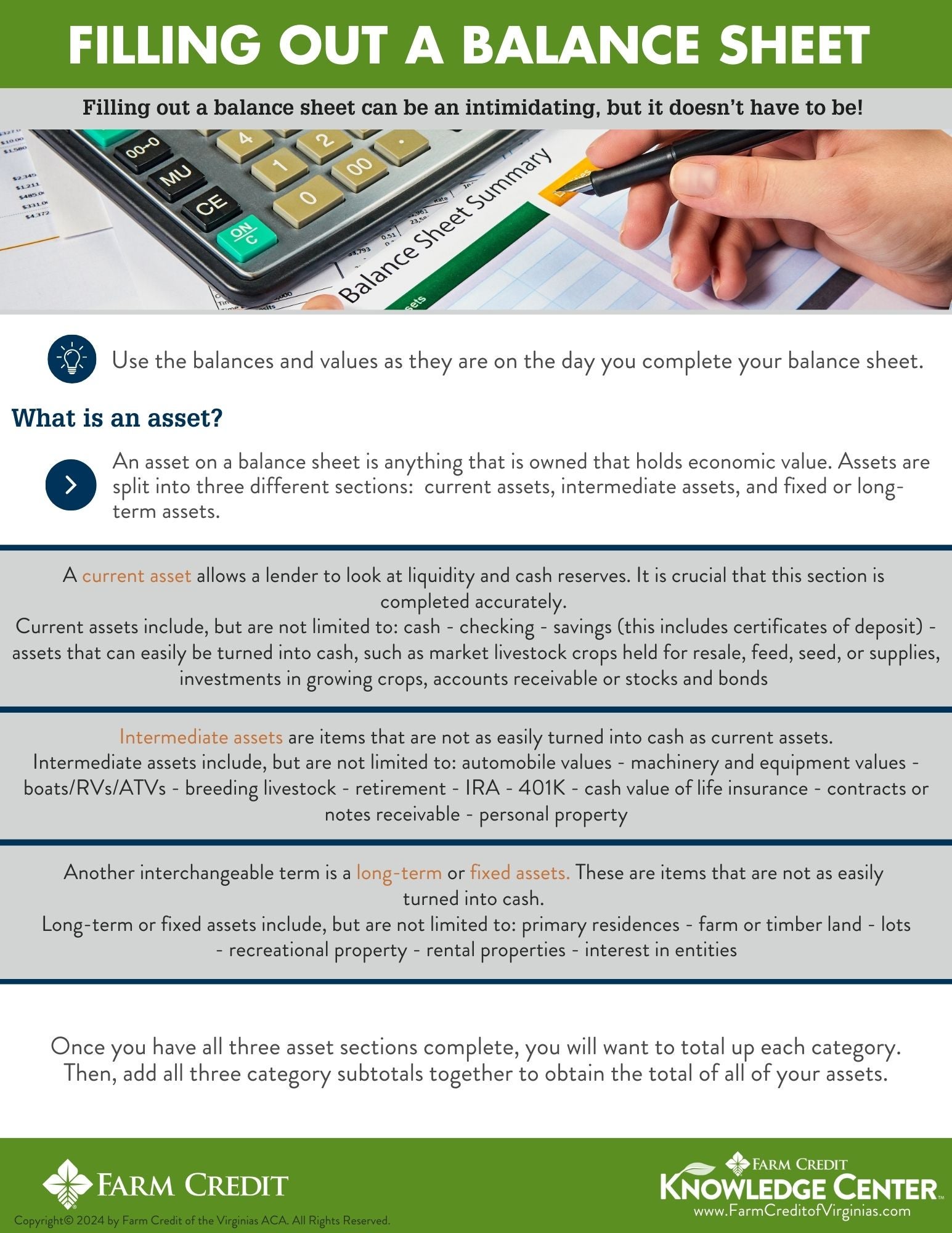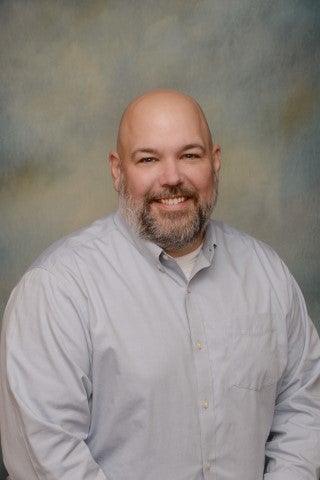Filling Out a Balance Sheet

Financial Literacy
Young, Beginning, Small & Veteran Farmers
Filling out a balance sheet can be an intimidating task. It can be extremely overwhelming to see all the boxes and work through the entire document; however, filling out a balance sheet doesn’t have to be scary. It is an important piece of the loan decision process.
Part of what can be intimidating about filling out a balance sheet is confusion by the vocabulary or not being 100% sure where to put specific information. In this article, learn more about filling out a balance sheet so you can tackle it with confidence!
First, it is important to remember the term balance sheet can be used interchangeably with the word financial statement. If you hear either of these terms be prepared to share both your liabilities and assets.
Also, a balance sheet is completed at a set point in time. Certain assets, like bank accounts or credit card balances, can change daily. Use the balances and values as they are on the day you complete your balance sheet.
What is an asset?
An asset on a balance sheet is anything that is owned that holds economic value. Assets are split into three different sections: current assets, intermediate assets, and fixed or long-term assets.
A current asset allows a lender to look at liquidity and cash reserves. It is crucial that this section is completed accurately. Current assets include, but are not limited to:
- Cash
- Checking
- Savings (this includes certificates of deposit)
- Assets that can easily be turned into cash, such as
- Market livestock
- Crops held for resale
- Feed, seed, or supplies
- Investments in growing crops
- Accounts receivable
- Stocks and bonds
- Stocks and bonds should not be confused with 401(k), IRA’s or 529 plans.
*If possible, it is good to have a statement to verify current assets. For example, if you put you have $250,000 in savings, have documentation to authenticate.
Intermediate assets are items that are not as easily turned into cash as current assets.
Intermediate assets include, but are not limited to:
- Automobile values
- Machinery and equipment values
- Boats/RVs/ATVs
- Breeding livestock
- Retirement
- IRA
- 401K
- Cash value of life insurance
- Contracts or notes receivable
- Personal property
- This is different for each person as personal property can include household items, tools, jewelry, guns, art, antiques, etc.
Another interchangeable term is a long-term or fixed assets. These are items that are not as easily turned into cash. long-term or fixed assets include, but are not limited to:
- Primary residences
- Farm or timber land
- Lots
- Recreational property
- Rental properties
- Time shares
- Interest in entities
- For entities, you will most likely need to complete a separate balance sheet for that entity. Once you have the ‘net worth’ of the entity, you will multiply the net worth by your ownership percentage. The value of your ownership percentage will then be transferred over to the personal balance sheet.
Once you have all three asset sections complete, you will want to total up each category. Then, add all three category subtotals together to obtain the total of all of your assets.
What is a liability?
Liability are the debts owed. The term liability can sometimes be interchangeable with debt. As with assets, liabilities are split into three different sections: current liabilities, intermediate liabilities, and long-term liabilities.
Current liabilities are notes/debts that are usually payable within a year. Current liabilities include, but are not limited to:
- Credit cards
- Accounts payable (veterinarian, seed supplier, feed supplier, etc.)
- Operating loans (lines of credit for farm/business expenses)
- Real estate or income taxes
- Unpaid medical bills
- Operating lease payments (example: payments due for rented land for farm operation)
- Time shares
- If you put it as an asset, the annual fees should also be listed in current liabilities
Intermediate liabilities are notes that are set to mature/pay off in a period of time greater than a year, but less 10 years. Intermediate liabilities include, but are not limited to:
- Auto loans
- Student loans
- Machinery and equipment loans
- Home equity loans
Long-term liabilities are notes that are set to mature/pay off in a period of time greater than 10 years. Long-term liabilities include, but are not limited to:
- Mortgages on primary residences or rental properties
- Land or lot loans
- Home equity lines of credit
Once you have all three liability sections complete, you will want to total up each category. Then, add all three category subtotals together to obtain the total of all of your liabilities.
Now, to determine your net worth, subtract your total liabilities from your total assets.
Total Assets – Total Liabilities = Net Worth
What items tend to be missed on a balance sheet?
Balance sheets encompass a plethora of information. It can be easy to mistakenly omit an expense or asset. Forgetting an expense or asset here happens; however, it is extremely important to fill out the entirety of the balance sheet.
Individuals often forget to list any liability that they are a ‘co-signor’ on. Even if you are not the one making the payments, your name can still be reported to the credit bureaus and the liability will be included on your credit report. Any co-signed liability needs to be listed on the balance sheet. These items will be listed in their appropriate location. For example, if you co-signed on a family member’s new vehicle, that would be listed in intermediate liabilities.
Some items on a balance sheet may not apply to you and that is okay! If there is a section you do not have asset or liability, it is acceptable to leave blank or put in $0.
What are important things to consider when filling out a balance sheet?
When listing your liabilities, be transparent. Like previously mentioned, the balance sheets are reconciled with the credit report. If a liability is on the credit report, but not on the balance sheet it can slow down the process.
Also, if the loan request you are working on will require market or breeding livestock, machinery, or equipment at collateral, it is recommended to use a separate sheet of paper or spreadsheet to itemize those assets and values. For example, instead of just writing $100,000 worth of breeding livestock, include an additional document that itemizes the total number of brood cows, bred cows/heifers, and bulls are included in that $100,000.
Next time you are asked to fill out a balance sheet, refer to these reminders. Remember, it doesn’t have to be intimidating! Break down each section, take your time, be transparent and you will be well on your way to an exceptional balance sheet!
Download the Filling Out a Balance Sheet resource guide.

Author:

Joey Cornwell
Regional Sales and Lending Manager
Farm Credit of the Virginias
IMPORTANT NOTICE AND DISCLAIMER
These materials are provided for educational and informational purposes only and do not constitute legal, financial, tax, or investment advice on any matter. We do not warrant that the materials provided are current and up-to-date with applicable laws and practices. You should not act or refrain from acting based on these materials or the information they contain without seeking legal advice from an attorney licensed in your jurisdiction or other appropriate professional. To the fullest extent provided by law, Farm Credit of the Virginias, ACA will not be liable for any loss or damage caused by your reliance on these materials or any information contained in these materials. Your use of the materials is at your own risk, and by accessing the materials, you hereby waive and hold harmless Farm Credit of the Virginias from any claims resulting therefrom.